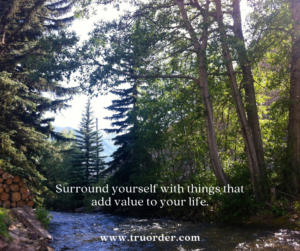How to Let Go of Clutter?
 Decluttering your space is more than just a physical task; it can take on an emotional journey. Whether you are a sentimentalist, paralyzed with ADHD or just have a tough time getting rid of clutter mentally, getting rid of stuff can be hard.
Decluttering your space is more than just a physical task; it can take on an emotional journey. Whether you are a sentimentalist, paralyzed with ADHD or just have a tough time getting rid of clutter mentally, getting rid of stuff can be hard.
- Understanding Emotional Attachment to Clutter
Why is it so hard to let go of things? Often, our difficulty in parting with items stems from emotional attachments or memories associated with them. Sentimentalists find it challenging to get rid of items that evoke strong feelings or memories. This can be compounded by the ‘endowment effect,’ a phenomenon where we irrationally overvalue something simply because we own it. Recognizing these emotional biases is the first step in overcoming them.
- Confronting Clutter with Critical Questions
To emotionally detach yourself from clutter, ask yourself some critical questions. For instance, if you had to buy an item at full price, would you still want it? This question helps assess the item’s real value to you, separate from any sentimental worth. Similarly, consider if you would keep an item if it were given to you by someone you dislike. This can help you determine if your attachment is to the item itself or the person associated with it.
- Do you genuinely like the item, does it make you feel good?
Think about whether each item brings you positive memories. If an object consistently evokes negative feelings or is simply indifferent, it’s a strong indicator that it’s time to let it go. Keeping only those things that bring genuine happiness can significantly lighten not just your physical space but also your mental space.
- The 12:12:12 Challenge: A Simple Yet Effective Decluttering Strategy
Joshua Becker’s 12:12:12 challenge is a practical approach to decluttering. The task is straightforward: find 12 items to throw away, 12 to donate, and 12 to return to their proper place. This method not only helps in decluttering but also in reorganizing your space. It’s a balanced approach that ensures you’re not just discarding things but also enhancing the organization of your environment.
- The 20/20 Rule for Decisive Decluttering
Created by Joshua Fields Millburn and Ryan Nicodemus, the 20/20 rule is another effective decluttering principle. Ask yourself: Can I replace this item for less than $20, and within 20 minutes? If the answer is yes, it’s safe to let go of the item. This rule is particularly useful for overcoming the ‘just in case’ mindset, where we hold onto things we rarely use on the off chance we might need them someday.
- Navigating ADHD Shutdown Mode in Decluttering
For individuals with ADHD, decluttering can be especially challenging. The overwhelming nature of the task can lead to what’s known as ADHD shutdown or paralysis, where one feels too overwhelmed to start or continue the task. It’s important to recognize this and approach decluttering in small, manageable steps, focusing on one area at a time to avoid information or task overload. Find someone to help you and keep you motivated.
- Creating a Decluttering Routine
Incorporate decluttering into your regular routine. Set aside a specific time each week to assess your space and remove or reorganize items. This consistent effort prevents clutter from accumulating and makes the task less overwhelming over time.
- Embracing a Minimalist Mindset
Adopting a minimalist approach doesn’t mean living with the bare essentials; it’s about surrounding yourself with things that add value to your life. Regularly question the purpose each item brings. This mindset shift is crucial for long-term decluttering success.
- Seeking Help When Needed
Sometimes, the task of decluttering can be too much to handle alone. Don’t hesitate to seek help from friends, family, or professionals. A fresh perspective can often make the process easier and more enjoyable.
- Celebrating Your Progress
Finally, acknowledge and celebrate your decluttering achievements, no matter how small. Each step towards a clutter-free space is a step towards a more serene and organized life.
Remember, the goal is not perfection but progress towards a more organized, peaceful living environment.
